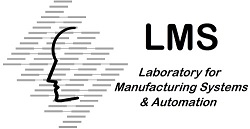
Close to market Services - LMS (EAP)
EAP: Early Adopters program. The EAP gave the chance to external companies to engage with experts from the pilot lines of the OPLN and test the technology developed within the frame of DIMOFAC.
About LMS Early Adopters Program
The Laboratory for Manufacturing Systems & Automation
Department of Mechanical Engineering and Aeronautics (LMS) at the
University of Patras has implemented close-to-market services to
external companies within the framework of the DIMOFAC project.
Solutions Implemented:
1. Machining Part Monitoring System
A low-cost cutting-edge milling chatter monitoring system, enabling the in-line and real-time assessment of “chatter” phenomenon, ensuring consistency, reliability and traceability of chatter-related defects.
2. Vision-Based Robot Grasping Solution
The development of a visionary robot grasping solution, leveraging advanced machine learning algorithms.
This solution empowered robots to efficiently identify and manipulate parts, optimizing assembly procedures with
unparalleled accuracy.
Key Insights
- 1. MOTIVATIONS FOR COLLABORATION
- 2. CHALLENGES FACED
- 3. BENEFITS OF COLLABORATION
- 4. FUTURE DEVELOPMENTS
- 5. RECOMMENDATIONS
Christos emphasized DIMOFAC’s aim to support technology adoption on a European level and see their research results being implemented.
Fotis highlighted the importance of supporting all technologies in adopting DIMOFAC’s developments and making operations easier for humans.
Fotis mentioned spending significant time on calibrating the vision system and ensuring communication between robots and the vision system.
Christos identified communicating with Legacy equipment and contextual controllers as the most common challenge.
Fotis described the collaboration as seamless, with DIMOFAC providing proactive support in resolving issues and facilitating easy integration of the programming business system.
Christos noted the perfect collaboration with beneficiaries, who showed genuine interest in the technology, provided valuable feedback, and engaged in discussions at various levels within their organizations.
Christos discussed the need for advancements in data acquisition systems and the evolution of sensing technology to enhance reliability and applicability across different machines and applications.
Fotis mentioned incorporating machine learning and deep learning approaches for more efficient part detection and path planning for robots along with developing user-friendly interfaces for easier operation.
Christos suggested budgeting initiatives to provide beneficiaries with a small budget for purchasing equipment and testing technology on their premises.
Fotis proposed incorporating user-friendly interfaces and creating smart grippers to accommodate different parts without the need for redesigning.
Testimonial:

Takeaways
LMS has shown that working closely with those who benefit from their technology has been crucial in making sure it works well in real-life situations.
By working smoothly together and with the people who benefit from their work being eager to try out new ideas, they’ve created solutions that fit exactly what’s needed.
The feedback LMS has got helped them understand how their technology can be used in practice, and it’s has also given them ideas for making it even better in the future.
This shows how important it is to test technologies out in real situations and to work closely with the end-users who will be using the technology to keep making it better.
Project info:
The use case DIMOFAC project which received funding from the European Union’s Horizon 2020 research and innovation programme under grant agreement No 870092, aiming to help factories implement a smart factory architecture that will allow them to be more reactive to a personalised demand and changing market dynamics.

